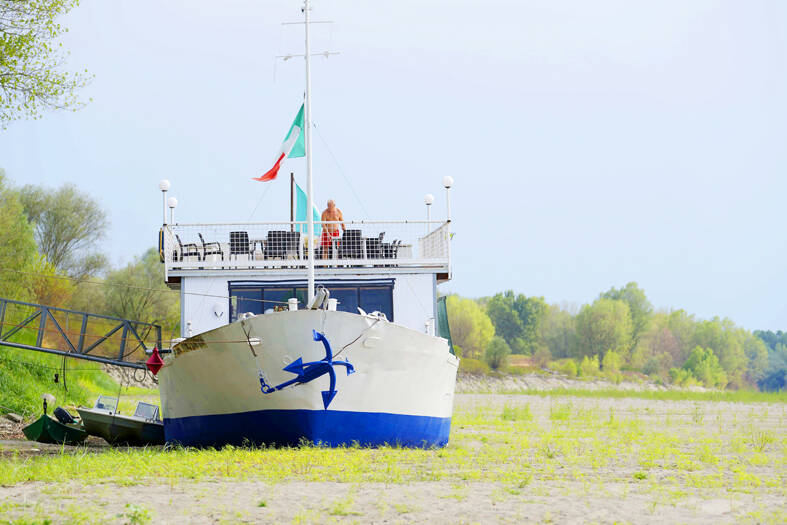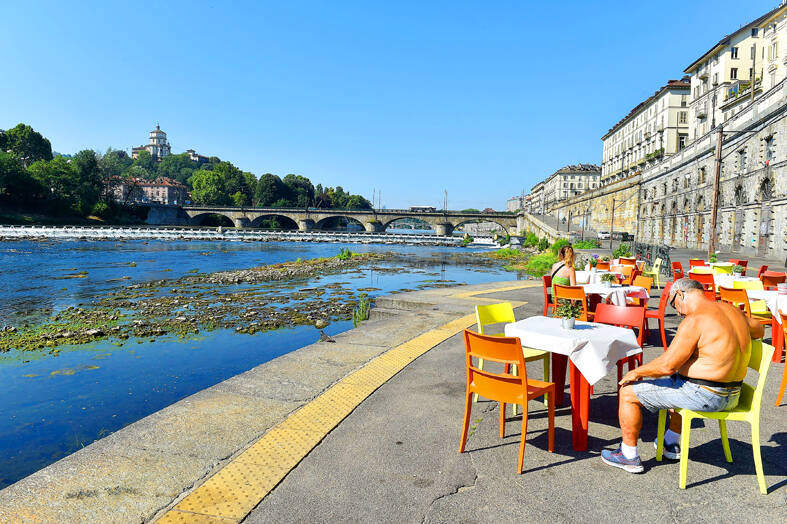There is only a feeble trickle in the irrigation canal feeding farmer Alessandro Salmoiraghi’s field of kiwi fruit in northern Italy.
“The constant problem is the lack of water,” he said. “Even if you diversify, when there is no water, there is simply no water, there is no life, no production.”
Salmoiraghi, 49, is the fourth generation of his family to farm Cascina San Donato, a 24-hectare plot of mainly grain, vegetables and fruit — primarily kiwi — on a normally lush plain just an hour’s drive west of Milan.

Photo: AP
“We used to have higher volumes of water. Now it is just a trickle. If another farmer starts irrigating tomorrow, the flow could easily stop,” Salmoiraghi said at his farm, which also boasts a shop selling fruit, vegetables and preserves.
Across large parts of Europe, climate change is fueling more extreme weather, including longer, harsher droughts and heatwaves that can spur crop failures.
That presents a threat to farmers such as Salmoiraghi and the millions who depend on Europe’s agriculture for food and a living. It is also forcing Italy’s government to take new steps to manage water disputes and renovate infrastructure.

Photo: Reuters
“The climate has changed in the last 10 years,” Salmoiraghi said, pointing to the lack of hard winters and frosty mornings.
Set in a normally lush plain, his farm is fed by the waters of Swiss Alpine glaciers that melt into the Ticino, one of the biggest tributaries of the Po, Italy’s longest river.
After poor winter rains and dismal Alpine snowfalls across northern Italy failed to replenish reserves, the arrival of spring has brought worries of more suffering following last year’s drought, the worst in 70 years.
The vast valley along the banks of the Po, stretching about 650km from the southern Alps and Italy’s northwestern border with France to the shores of the Adriatic Sea in the east, accounts for about one-third of Italy’s agricultural production.
Last year, people could walk across the river bed in places. A boat sunk in World War II stood high and dry in the mud and gauges showed water levels below what normally counts as zero.
Italy is far from alone. Agricultural production is also under strain in France and Spain and the UN Food and Agriculture Organization says that 3.2 billion people worldwide live in areas facing high to very high water scarcity.
Attilio Fontana, president of the Lombardy region, centered on Milan, last month said that regional water storage levels were less than half what they normally are at this time of year.
Coldiretti, Italy’s main farmer’s association, said the sector had lost about 6 billion euros (US$6.6 billion) last year and predicted 300,000 businesses would lose more if the drought does not end.
Experts say that would require almost nonstop rain from now until next month and June, when most farmers start irrigating their fields.
“If no rainfall comes in late spring, we will enter into emergency management, like we did last year, postponing the irrigation season,” said Massimo Sertori, the Lombardy councilor responsible for water resources.
Italy grows about 50 percent of the rice produced in the EU, but is set to cut output this year as farmers plant less because of the drought, Coldiretti said.
About 94 percent of Italy’s crop is grown in Lombardy and in Piedmont, around Turin.
Other crops are also at risk.
“We are especially worried about the spring crops and then vegetables and fruit,” said Lorenzo Bazzana, an economist at Coldiretti.
“At this time of the year, farmers begin sowing maize, soy, sunflower, rice and planting tomato and potatoes. All of these face higher risks,” he said.
If farmers scale back cultivation, it could hurt the whole agricultural supply chain. Corn, for example, is an important fodder for pigs and cows, which supply the ham and cheese products for which Italy is world famous.
Italy exported 61 billion euros of food and agricultural products last year, accounting for 15 percent of its GDP.
Salmoiraghi lost about 30 percent of his corn harvest last year and fears water scarcity will soon become the new normal.
The latest report from the Intergovernmental Panel on Climate Change predicts that rainfall in the Po Valley would vary more in the coming years, with an increase in extreme weather events.
Extreme drought is already affecting 6 percent of towns in Lombardy and Piedmont, with 19 of them experiencing the highest level of shortage, said Utilitalia, a federation of utility companies.
It said that some towns had already started receiving water in tanker trucks.
“The situation remains utterly critical,” said Alessandro Bratti, general secretary of the authority overseeing the River Po basin.
Last year, water from large lakes helped ease the drought’s effects, but water in Lake Garda, which eventually flows into the River Po, is below half of normal levels, the Po River District Basin Authority said.
Italian Prime Minister Giorgia Meloni last month set up a control room to monitor water capacity across the country and is to appoint a national commissioner to oversee the issue.
The commissioner would be able to intervene in issues of water management and mediate between state bodies. Last week, the Cabinet approved a raft of short-term measures to simplify procedures and speed up water infrastructure works. Those who draw water illegally can now face fines of up to 50,000 euros.
Inadequate water storage is a big problem. A new study by the Energy and Water Foundation and Proger KSA said that Italy receives an average annual rainfall of 301 billion cubic meters, but collects and redistributes only 11 percent of it.
The study also found that the country’s 531 major dams are operating far below capacity due to technical issues and lack of investment.
At the local level, the Lombardy government has asked water companies and hydroelectric operators to limit their usage.
“We are seeking a point of equilibrium that allows us to fill the lakes, without hampering energy production,” Sertori said.
Sertori said that in the long run, he believes lakes will be key to boosting water storage, with the region undertaking renovation work to expand capacity.
While waiting to see what effect the measures have, farmers are looking for their own ways to adapt.
Salmoiraghi last year bought a new, more efficient irrigation system, but he was also helped by the rise in commodity prices offsetting the loss in productivity.
This year, he has already sown more crops, including soy, that require less water.
For now, he is just thinking about reducing the possible harm. “You opt for the easy crops. If it turns bad, at least I lose only one harvest and not the whole season.”

Semiconductor business between Taiwan and the US is a “win-win” model for both sides given the high level of complementarity, the government said yesterday responding to tariff threats from US President Donald Trump. Home to the world’s largest contract chipmaker, Taiwan Semiconductor Manufacturing Co (TSMC, 台積電), Taiwan is a key link in the global technology supply chain for companies such as Apple Inc and Nvidia Corp. Trump said on Monday he plans to impose tariffs on imported chips, pharmaceuticals and steel in an effort to get the producers to make them in the US. “Taiwan and the US semiconductor and other technology industries

SMALL AND EFFICIENT: The Chinese AI app’s initial success has spurred worries in the US that its tech giants’ massive AI spending needs re-evaluation, a market strategist said Chinese artificial intelligence (AI) start-up DeepSeek’s (深度求索) eponymous AI assistant rocketed to the top of Apple Inc’s iPhone download charts, stirring doubts in Silicon Valley about the strength of the US’ technological dominance. The app’s underlying AI model is widely seen as competitive with OpenAI and Meta Platforms Inc’s latest. Its claim that it cost much less to train and develop triggered share moves across Asia’s supply chain. Chinese tech firms linked to DeepSeek, such as Iflytek Co (科大訊飛), surged yesterday, while chipmaking tool makers like Advantest Corp slumped on the potential threat to demand for Nvidia Corp’s AI accelerators. US stock

The US Federal Reserve is expected to announce a pause in rate cuts on Wednesday, as policymakers look to continue tackling inflation under close and vocal scrutiny from US President Donald Trump. The Fed cut its key lending rate by a full percentage point in the final four months of last year and indicated it would move more cautiously going forward amid an uptick in inflation away from its long-term target of 2 percent. “I think they will do nothing, and I think they should do nothing,” Federal Reserve Bank of St Louis former president Jim Bullard said. “I think the

SUBSIDIES: The nominee for commerce secretary indicated the Trump administration wants to put its stamp on the plan, but not unravel it entirely US President Donald Trump’s pick to lead the agency in charge of a US$52 billion semiconductor subsidy program declined to give it unqualified support, raising questions about the disbursement of funds to companies like Intel Corp and Taiwan Semiconductor Manufacturing Co (台積電). “I can’t say that I can honor something I haven’t read,” Howard Lutnick, Trump’s nominee for commerce secretary, said of the binding CHIPS and Science Act awards in a confirmation hearing on Wednesday. “To the extent monies have been disbursed, I would commit to rigorously enforcing documents that have been signed by those companies to make sure we get